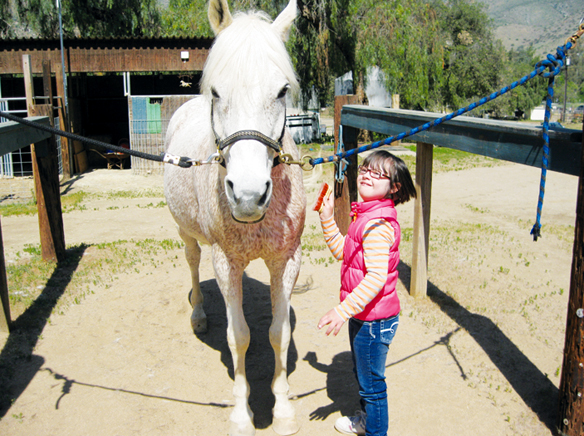Nestled in the mountains near El Monte County Park in Lakeside, Robin Pawl founded The Magic Horse Therapeutic Riding Center in 2004 to bring therapeutic riding lessons to San Diego. She brings together an unbridled love of horses, biology, personal fitness and life coaching to make a life-enhancing difference for differently abled through the magic of the horse.
Nestled in the mountains near El Monte County Park in Lakeside, Robin Pawl founded The Magic Horse Therapeutic Riding Center in 2004 to bring therapeutic riding lessons to San Diego. She brings together an unbridled love of horses, biology, personal fitness and life coaching to make a life-enhancing difference for differently abled through the magic of the horse.
Clay Titus’s 15-year-old son Avery cannot walk, but benefits from hippotherapy he receives during weekly, one-hour sessions. The Magic Horse is a unique equine physical therapy that clients say works wonders.
“It’s something he can do, can control; he asks for it all week, looks forward to it every Saturday,” said Titus.
Titus makes the hour-long drive from Carmel Valley and said it is worth it and he supports Pawl’s ongoing mission.
“Physically it helps Avery, it’s a good, stimulating workout,” Titus said.
Hippotherapy is a form of physical, occupational and speech therapy where the characteristic movements of a horse to provide graded motor and sensory input.
“That motion is put into their (rider’s) pelvis and up through their body,” said Pawl. “It stimulates the body, the brain.”
Pawl said the dynamics of hippotherapy is the motion in a horse’s pelvis is the same kind in the human pelvis – side-to-side, forward-and-back – when we walk.
Eight-year-old Josie with Down syndrome is a client at the Center. Her mother, Lisa Mota said she is only one of many clients benefiting from therapeutic horseback riding.
“She loves the horse, the whole experience,” said Mota. “She really benefits from Robin’s calm demeanor and her focus on taking it slowly, understanding people’s needs.”
Cliff said this equine treatment is unquestionably stimulating for Avery, whose smile never leaves his face during sessions. Avery, born prematurely and oxygen deprived, which has left him with limited motor and sensory skills, he said.
Pawl, with the help of Cliff and a volunteer, takes Avery astride one of her horses around a fenced arena and along a trail ride asking him to do things to develop his motor and sensory skills, like grasping suspended objects or picking out and opening colored eggs with prizes inside.
“Avery can’t stand on his own, so he gets more benefit from just being on a horse and moving,” said Pawl. “It’s challenging for him to sit up there and get moved around and have to keep himself balanced. It’s a lot of work.”
Pawl said a therapeutic riding session is a workout for her horses too.
“They’re an interesting challenge because they can be real cooperative, and yet they’re like a little kid always challenging you,” she said.
Pawl said horses are non-verbal and read people well, and that horse language and people language are different.
“They’re looking at our body language all the time,” said Pawl. “It’s hard work for them putting up with unbalanced riders, or riders who can’t be real gentle, can’t stay focused, or can’t remember what they’re supposed to do. So they (horses) have to be very forgiving.”
Pawl’s individualizes her therapy from patient to patient. With Josie, the overall objective is the same as with Avery, though applied differently.
“Josie really needs to communicate more, work on hand strength and mobility,” said Mota.
Pawl uses occupational and speech therapy requiring her daughter to groom and dress a horse before riding the animal, said Mota.
“You put on the bridle and everything else and it’s very detailed work,” said Mota. “Robin lets Josie do everything herself. Josie also has some speech problems, so Robin makes her communicate more.”
Pawl earned certification as a registered level therapeutic riding instructor through the North American Riding for the Handicapped Association.













